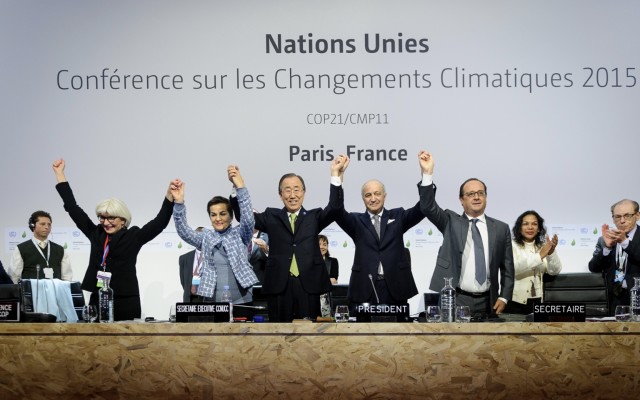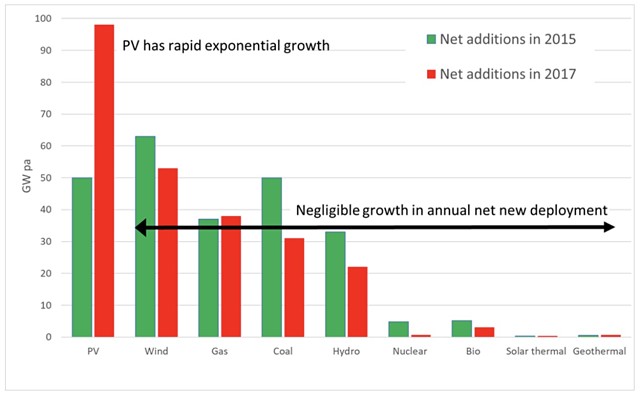Australia set to run on 100% renewable energy within 15 years

Australia is on track to reach its Paris Agreement renewable energy target by 2025
Australia is set to reach its target of 100% renewable energy by the early 2030’s, provided current uptake of renewable energy options in the residential and commercial sectors remains strong.
The Australian renewables energy industry will install more than 10 gigawatts of new solar and wind power before the end of 2019 and if that rate is maintained, Australia would reach 50% of its renewables target in 2025.
The reduction target, set under the famed Paris Agreement into global climate change, forms part of a commitment made by Australia in 2015 to cut carbon emissions nationwide by up to 28% of 2005 levels by the year 2030.

The introduction of the ‘Paris Agreement’ to combat climate change held in Paris, France on 12 December 2015.
It represents reductions of around 52% in emissions per capita and around 65% in the emissions intensity of the economy between 2005 and 2030.
Homeowners and industry have embraced the renewables challenge so well that it now seems possible the nation will reach the equivalent of 100% renewables for its electricity supply well before then.
A report by the Energy Exchange Institute at Australian National University, says merely keeping up the current rate of renewable energy deployment – roughly divided between solar photovoltaics (PVs), wind farms and rooftop solar PVs – would meet the country’s entire emissions reduction task for the whole economy by 2025.

Net new global generation capacity additions in 2015 and 2017.
That doesn’t take into account recent announcements at State level to make solar a more attractive option to consumers.
Federal initiatives
In 2015, the Senate passed a Renewable Energy Target (RET) which aims to have more than 23.5% of Australia’s electricity derived from renewable sources by 2020.
The scheme is split into two areas – large-scale for the establishment and expansion of renewable energy power stations with a target of 33,000 gigawatt-hours of renewable electricity generation by 2020; and small-scale which includes financial incentives for households, small businesses and community groups to install systems such as solar hot water heaters, heat pumps and solar PV systems.
The RET is supported by the Australian Renewables Energy Agency, established in 2012 to promote and fund researchers, developers and businesses which demonstrate the feasibility and potential commercialisation of their renewables energy technologies and projects.
According to some reports, “surging numbers” of commercial and industrial projects are applying for accreditation under the RET.
By contrast, the Turnbull government’s National Energy Guarantee struggled to find favour with the states and the coalition from the moment it was proposed last year.
Under the proposal, power retailers would have been required to meet minimum reliability and pollution standards as part of efforts to cut Australia’s carbon emissions.
But WA and the Northern Territory – neither of which are connected to the national electricity market – rejected the National Energy Guarantee, and opposition snowballed from all corners until the idea was unceremoniously dumped last month, in much the same way that Turnbull was a short time later.
Western Australia
While WA was never supportive of Turnbull’s proposal, it has always been well placed to take advantage of the renewables energy trend, particularly in solar and wind.
APA Group for example, is set to deliver the second and largest grid-connected hybrid wind and solar facility in WA, with a decision in August to add a 17.5 megawatt solar farm to the 130 megawatt Badgingarra wind park near Geraldton as part of a late push into large scale renewables.
Both farms are contracted to Alinta Energy, which is looking to expand its retail business in WA and has extended its contract with APA to 2035 – beyond the closing date of the RET scheme.
Badgingarra will be the second of its kind in the state, after the Emu Downs wind and solar parks also near Geraldton.
Meanwhile in July, WA Energy Minister Ben Wyatt called for a scrapping of government subsidies for rooftop solar panels, claiming the cost of the units had fallen to a more accessible price point for West Australian households.
Panel incentives have to date been subsidised up front to homeowners through the “small scale” section of the RET.
South Australia
Currently leading the nation in the uptake of wind energy and rooftop solar, South Australia’s renewable sources account for more than 40% of electricity generated in the state.
British billionaire Sanjeev Gupta is the brains behind the development of the Cultana solar project in the state’s Upper Spencer Gulf region, to include 780,000 solar panels capable of generating 600GWh of energy generation per year – enough to power 96,000 homes while offsetting 492,000 tonnes of carbon dioxide.
The project – slated for development in 2019 – will join a second solar project to be built nearby under the management of Mr Gupta’s company SIMEC ZEN Energy to become one of the country’s largest solar farms.
A separate battery farm project also managed by Mr Gupta with $10 million assistance from the state government will have a planned capacity of up to 140 megawatt-hours and will store wind power from a planned farm near Adelaide.
Also on the battery bandwagon is German solar battery firm sonnen, which plans to set up a manufacturing plant in South Australia capable of building 10,000 batteries a year.
Up to 40,000 households will be eligible for subsidies to install the flat batteries under the state government’s $100 million rebate scheme.
Victoria
The garden state is forging ahead with plans to build six renewable energy plants by 2020 – three solar and three wind – producing 928 megawatts capable of powering 645,000 homes.
The plants were awarded by Premier Daniel Andrews via a reverse auctions scheme which saw project developers compete to be the lowest-cost provider.
Around the same number of homes will also benefit from half-price rooftop solar panels being offered by the government as part of a $1.24 billion Solar Homes scheme announced in August.
Families earning less than $180,000 per year with homes valued at less than $3 million will be eligible for the scheme, in which the government will pay $4550 upfront to install the panels and households would repay the remaining half over four years.
They are not the only prizes up for grabs though – with the November election approaching, the Premier has pledged additional incentives for householders if his party wins, helping it transition closer to its legislated renewables target of 25% by 2020 and 40% by 2040.
Also on offer will be half-price solar batteries for families who have already installed solar panels – with the catch that it will only be offered to 10,000 homes – as well as a discounted solar hot water scheme for around 60,000 homes.
Queensland
In July, Energy Minister Dr Anthony Lynham said the sunshine state will have 2164 megawatts of renewable energy ready by mid-2019 – a level of energy which is enough to power 800,000 homes, according to the Clean Energy Council.
Darling Downs will be one of the more significant contributors, as it experiences a renewables energy boom to replace the economic distress felt in the region when the coal-seam gas industry scaled back its operations.
At least one wind and 11 solar farms worth $6 billion have been approved to date.
The first big project – a $200 million, 110-megawatt photovoltaic solar farm near Dalby, owned by APA Group – will have approximately 430,000 solar panels covering 250 hectares when it is completed by year end.
This year, the local Toowoomba council approved a billion-dollar project which, if it goes ahead, could become the biggest in the world by the time construction finishes in a decade.
In July, construction started on Stage 2 bulk earthworks for the 100 megawatt Yarranlea solar farm in neighbouring Pittsworth, by Chinese company Risen Energy.
The farm – which will have an operating life of at least 30 years – will utilise the latest PV panel technology and eventually integrate battery storage to allow it to supply power to the grid during peak periods.
The University of Queensland is set to become the first of its kind in the world to offset 100% of its electricity needs from its own renewable energy asset.
The university will offset current and projected future annual usage through a proposed $125 million solar farm in the Southern Downs region, which will generate about 154,000 megawatt hours of clean energy each year – enough to power 27,000 average homes.
When the project is completed at end 2019, it will help the university to become energy neutral by 2020.
It hasn’t all been good news for Queensland though, with accusations in June that the state government has been concealing its financial support for large-scale renewables projects under its Solar 150 funding initiative, and related calls for the spending to be made public.
New South Wales
In August, Premier Gladys Berejiklian earmarked $85 million for the development of clean energy projects and backup power systems in regional areas of NSW with a view to reducing household power bills.
The funding included $55 million to help the private sector develop and accelerate clean energy technology for regional communities, such as pumped hydro.
The latest initiatives follow the government’s earlier commitment to major investment in energy efficiency measures, including funding for energy efficiency upgrades for families and businesses, energy efficient bulbs in 60,000 street lights, and solar panels for homes and Government buildings.
Tasmania
In April 2017, the island state of Australia began investigating the potential to develop advanced wind and hydropower energy solutions via its ‘Battery of the Nation’ initiative.
Through the initiative Tasmania aims to offer its inhabitants energy that is clean, reliable and affordable.
A study released by Hydro Tasmania states that pumped hydro could generate 4800MW of potential capacity across 14 sites in Tasmania.
Plans for the Battery of the Nation initiative are still in their pre-feasibility phase and have been left out of the federal National Energy Guarantee, despite Tasmania receiving funding from the Australian Renewable Energy Agency for related hydro projects. The exclusion for now is likely due to the early stage nature of the initiative.
Cost barriers
The upfront costs of solar energy are often the biggest barriers for families wanting to take advantage and reduce their power bills.
Melbourne’s Endless Solar, listed on the NSX under code ESCLV, has been inundated with calls since the government announced its financial incentives.
“People always want the government to help them with these sort of hefty investments,” national sales director Steve Wesselink told Small Caps.
“Nobody wants to stick their hand in their pocket completely on their own – since the government announced its latest schemes, there’s been a lot more interest.
“Our phones in Victoria and New South Wales have been running off the hook.”
Endless Solar is in the throes of new technology development, working with the Australian National University to prove and commercialise “Cool Solar” – an airconditioning system which uses solar-heated water to produce cool air and potentially equating to 60% of a household’s energy bill.
“Australia’s uptake of solar energy options makes a massive contribution to the goals of the Paris Agreement,” said Mr Wesselink.
“The rising price of gas has been a big bargaining factor – as people realise that they’re going to have trouble paying their gas bills over the long-term, they’ve started turning to companies like ours for alternatives to gas-supplied heating.
He said while solar can entail a reasonable upfront investment, the payback period is quick.
“A solar hot water system has an average 15-year lifespan compared to less than 10 years for your average air conditioning system so while it costs more at the outset, you’re ahead in the long run and you’re helping the environment at the same time,” he said.
“Going solar is an obvious choice.”
